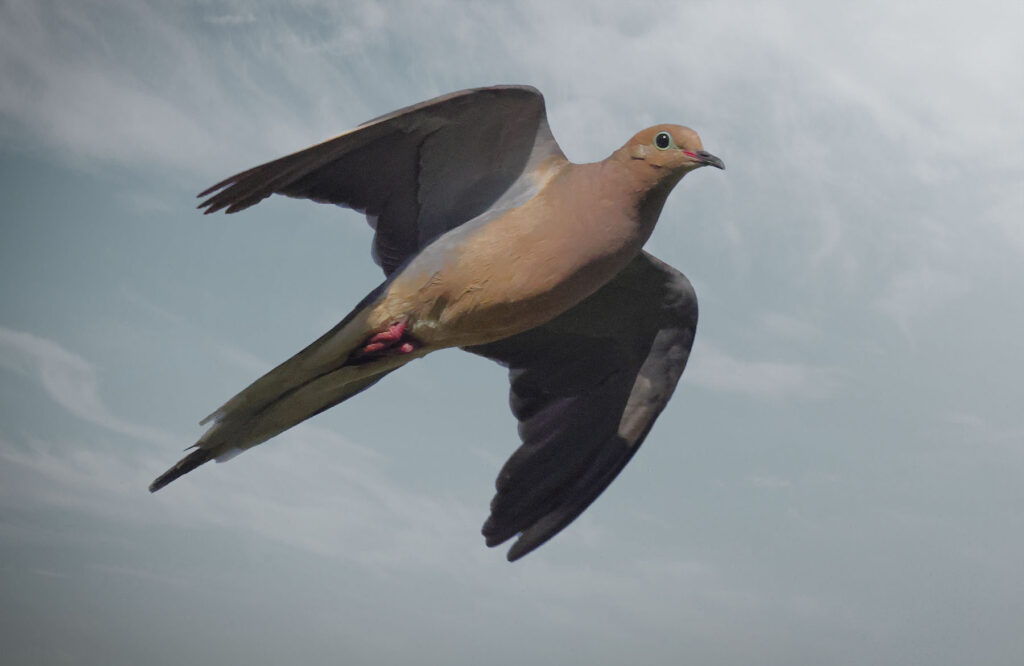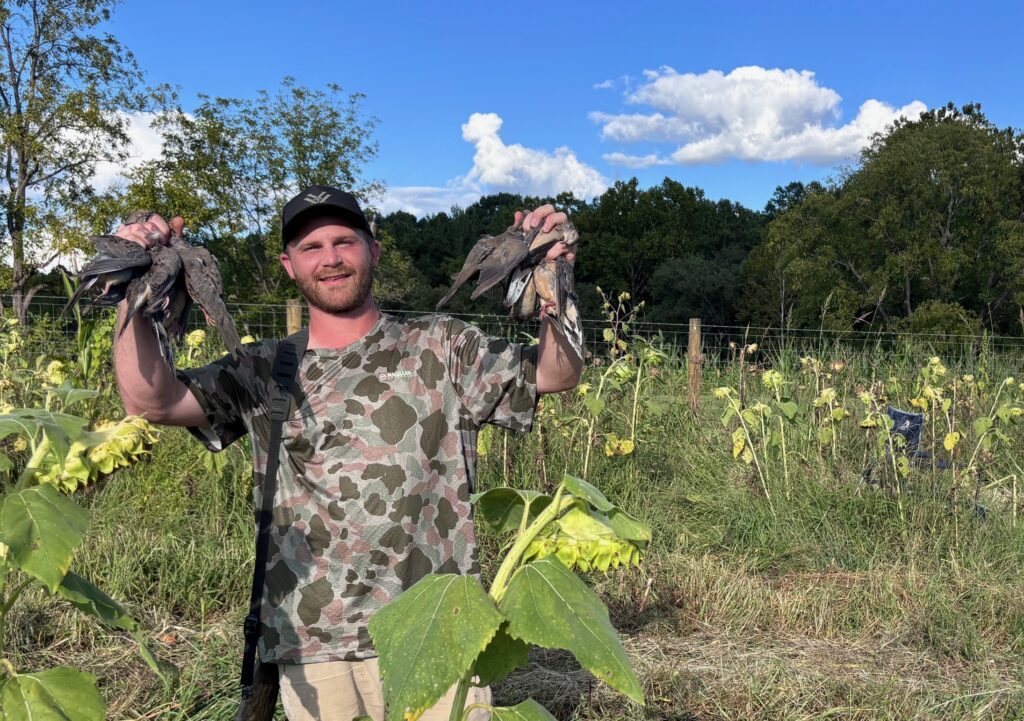Tactics
National Deer Association’s 5 Top Tips for Late-Season Deer Hunting
December 17, 2025 •iSportsman Staff
September 4, 2025
Walking slowly through grassy rangeland dotted by scattered trees and brush, I paused periodically to look and listen for signs of game.
I stalked my way down a path through the pine savanna. A small creek barely trickling with water nourished thick brush growing on both sides of the little stream in this dry Texas countryside. The narrow path led through a break in the green vegetative wall growing along the creek.
As I approached the break in vegetation, the rocky creek bed erupted with the distinctive whistling clatter made by long, elegant elliptical wings of a magnificent game bird. Any bird hunter who ever experienced a dove flushing would instantly recognize that sound as mourning doves scattered in all directions. Momentarily startled by the rush, I quickly recovered and fired.
Most dove hunters stand in a tree line, along a fence or at the edge of a field. They might sit in a folding chair surrounded by high weeds watching for doves to fly into range. That’s fun, but rather than wait for the swift and majestic birds appear, some sportsmen prefer a more dynamic form of hunting. They go looking for doves and roust them.

When attempting to stalk doves, you need to be ready to make quick shots on the fast-flying birds. Patrick “Buzz” Hayes Photo
Almost like quail hunting, sportsmen stalk where birds might hide. Stay alert when approaching good cover. At any second, flushing birds could generate adrenaline-pumping excitement, sometimes almost under the feet of hunters.
To jump doves, sportsmen must first find them. Doves like fields or grassy savannas punctuated by scattered trees, brush or fencerows. They tend to avoid marshes, swamps and thick forested areas, but doves do gather at forest edges and other openings.
To survive, doves need food, cover, water and grit. With supercharged metabolism, doves can consume their weight in seeds each day to keep their energy up. The small birds feed in places with bare dirt at ground level but need leafy canopy cover above them so they can hide from hawks and other predators. Find these elements to find the birds. First, look for food sources.
“A dove’s diet consists of about 99 percent seeds,” explains Seth Maddox, an Alabama biologist. “They go for native vegetation, such as grass seeds, herbs and weed seeds. They also eat cultivated grains such as corn, millet, sorghum, also called milo, even peanuts. Occasionally, doves eat berries or maybe even something like snails for calcium. They also need to drink a good amount of water every day.”
After filling their bellies, doves look for places to rest and digest. They perch in tall trees, on electrical wires or other good vantage points for spotting danger. They might stay perched until they get hungry again or thirsty unless something disturbs them.
Doves swallow seeds whole. To break up rough seeds, they swallow small pieces of gravel or sand. Sportsmen often find doves “dusting” or picking up bits of rock around grit piles or sandy patches.
Then, they need water to wash everything down. The diminutive birds could drink out of a puddle in a tire rut on a gravel or dirt trail. Old dirt or gravel paths and trails make great places to jump doves because they provide the birds with food, cover, grit and water, everything it needs.
Doves commonly stay around small streams, creek beds, stock tanks or ponds. A gravelly sandbar with scrubby brush growing along a stream or pond shoreline near croplands could provide an excellent place to jump doves. Walk slowly and quietly along the shorelines.
Tree lines, fencerows, powerlines, firebreaks and other clearings also make great places to stalk doves. Walk slowly through open fields or savanna lands looking and listening.

Don’t just wait. Taking the hunt to the birds can help you round out your limit. Doug Howlett Photo
At times, sportsmen can work in teams to take more doves. Around powerlines or wide trails, one person could walk on one side while another walks along the other side. At fencerows, creeks or narrow tree lines, sportsmen walking on both sides catch birds flushing from any direction. Always pay attention to the location of other hunters and watch the shots, being sure to only take shots that are above head high, never level.
Food plots meant for deer also make great places to look for doves. At a food plot, one person walks around it in a clockwise fashion while another goes counterclockwise.
Occasionally, startled doves only fly short distances. They might alight in a nearby tall tree or bush. Sometimes, sportsmen can flush them again, especially in an area with good cover.
Most people probably only hunt doves when the early season opens, perhaps just opening day or weekend. As other seasons begin, they forget about doves and turn their attention to other game. Later in the season, dove hunters see little to no competition, even on the most heavily pressured public lands. Therefore, some of the best jump-shooting happens later in the season.
Many doves remain near where they were born all year long, but like ducks and other birds, others migrate south when cold weather hits. Some of the best dove hunting occurs just ahead of a major cold front. Migrating birds augment the depleted resident population, especially in the Deep South.
“Most dove hunting is done during the first two weeks of the season,” reported Rick Hamrick, a Mississippi biologist. “Similar to waterfowl, abundance of migratory gamebirds can be very dependent on migration status. Many doves harvested in the early season are produced locally. As doves begin to migrate from northern latitudes, late season can be a great time to find large numbers of doves in Mississippi.”
Walking up on doves could put birds in the bag with considerable excitement, but hitting the swift and erratic fliers takes skill. Mourning doves can exceed 55 miles per hour. The feathered rockets fly with twisting flight patterns and can seemingly predict where pellets fly and dodge them. For jumping doves, use high-powered 7 1/2 shot with an improved cylinder or modified choke.
Jumping doves creates an excellent way to introduce children to the sport. They don’t need to sit still and quiet for long hours in a blind. They can socialize, talk and move around. More experienced hunters could teach them woodcraft, preparing them for other sporting endeavors. In the right spot, shooters could experience exhilarating action.
 John N. Felsher is a professional writer, broadcaster, photographer, editor and consultant. An avid sportsman, he’s written more than 4,000 articles for more than 176 different magazines on a wide variety of outdoors topics. He also hosts an outdoors tips show for WAVH FM Talk 106.5 radio station in Mobile, Ala. Contact him at j.felsher@hotmail.com or through Facebook.
John N. Felsher is a professional writer, broadcaster, photographer, editor and consultant. An avid sportsman, he’s written more than 4,000 articles for more than 176 different magazines on a wide variety of outdoors topics. He also hosts an outdoors tips show for WAVH FM Talk 106.5 radio station in Mobile, Ala. Contact him at j.felsher@hotmail.com or through Facebook.
